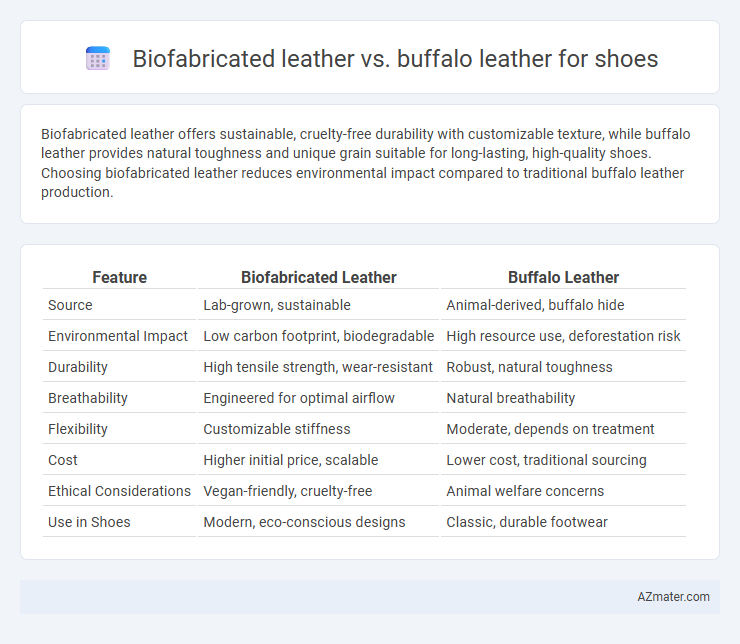Biofabricated leather offers sustainable, cruelty-free durability with customizable texture, while buffalo leather provides natural toughness and unique grain suitable for long-lasting, high-quality shoes. Choosing biofabricated leather reduces environmental impact compared to traditional buffalo leather production.
Table of Comparison
| Feature | Biofabricated Leather | Buffalo Leather |
|---|---|---|
| Source | Lab-grown, sustainable | Animal-derived, buffalo hide |
| Environmental Impact | Low carbon footprint, biodegradable | High resource use, deforestation risk |
| Durability | High tensile strength, wear-resistant | Robust, natural toughness |
| Breathability | Engineered for optimal airflow | Natural breathability |
| Flexibility | Customizable stiffness | Moderate, depends on treatment |
| Cost | Higher initial price, scalable | Lower cost, traditional sourcing |
| Ethical Considerations | Vegan-friendly, cruelty-free | Animal welfare concerns |
| Use in Shoes | Modern, eco-conscious designs | Classic, durable footwear |
Introduction to Biofabricated Leather and Buffalo Leather
Biofabricated leather is a sustainable alternative created through cell culture technology that mimics the texture and durability of traditional leather without involving animal hides. Buffalo leather, sourced from water buffalo, is known for its toughness, natural grain patterns, and resistance to wear, making it a popular choice for durable footwear. Comparing both, biofabricated leather offers an eco-friendly option with reduced environmental impact, while buffalo leather delivers established strength and a unique authentic look for shoe manufacturing.
Material Composition and Production Processes
Biofabricated leather is composed of lab-grown collagen fibers that mimic animal hide without using actual animal products, relying on cellular agriculture techniques for production. Buffalo leather, derived from the tanned hide of water buffalo, contains natural fibers and oils preserved through traditional tanning and finishing processes that enhance durability and breathability. The production of biofabricated leather involves controlled microbial fermentation and scaffold structuring, leading to a sustainable alternative, whereas buffalo leather requires resource-intensive animal rearing and chemical treatments.
Environmental Impact Comparison
Biofabricated leather significantly reduces environmental impact by eliminating animal farming, which is a major source of methane emissions and land degradation associated with buffalo leather production. It requires less water and energy during manufacturing, minimizing carbon footprint compared to traditional buffalo leather that involves intensive resource consumption and chemical tanning processes. The synthetic nature of biofabricated leather also lowers pollution risks, making it a more sustainable alternative for eco-conscious shoe production.
Durability and Performance in Footwear
Biofabricated leather offers a sustainable alternative to traditional buffalo leather, featuring enhanced durability due to its engineered fibers that resist wear and tear in high-stress footwear applications. Buffalo leather remains valued for its natural toughness, moisture resistance, and breathability, making it a preferred material for performance-heavy shoes requiring long-lasting support and comfort. Innovations in biofabrication now enable comparable strength and flexibility to buffalo leather, positioning it as a competitive material in durable, high-performance footwear manufacturing.
Aesthetic Qualities and Customization Options
Biofabricated leather offers a smooth, consistent texture with the ability to incorporate unique patterns and colors through controlled manufacturing processes, enhancing aesthetic versatility for shoe design. Buffalo leather features a natural, rugged grain and rich patina that develops over time, providing an authentic, classic appeal favored in traditional footwear. Customization in biofabricated leather allows for precise alterations in thickness, finish, and coloration, while buffalo leather customization relies more on artisanal techniques like dyeing and embossing, reflecting inherent material characteristics.
Comfort and Wearability Over Time
Biofabricated leather offers superior breathability and flexibility compared to traditional buffalo leather, enhancing overall comfort during extended wear. Its uniform texture reduces the likelihood of blister formation and adapts better to foot movements, ensuring prolonged wearability without compromising fit. Buffalo leather, while durable and naturally rigid, tends to soften gradually but may cause initial stiffness and discomfort during long-term use.
Ethical and Animal Welfare Considerations
Biofabricated leather eliminates animal suffering by using lab-grown cells, making it a cruelty-free alternative to traditional buffalo leather, which involves animal slaughter and often raises significant animal welfare concerns. Buffalo leather production can contribute to unethical farming practices and environmental strain due to livestock management, while biofabricated leather supports sustainable practices by reducing the need for animal farming. Choosing biofabricated leather aligns with growing consumer demand for ethical fashion by minimizing animal exploitation and promoting cruelty-free manufacturing processes.
Cost Efficiency and Market Availability
Biofabricated leather presents higher initial production costs compared to traditional buffalo leather but offers potential long-term savings through scalable manufacturing and reduced raw material expenses. Buffalo leather remains more cost-efficient due to established supply chains, widespread availability, and lower production costs driven by established tanning processes. Market availability heavily favors buffalo leather with extensive supplier networks and consistent quality, while biofabricated leather is emerging, limited by nascent production capacity and higher market prices.
Sustainability and Future Trends
Biofabricated leather offers a sustainable alternative to traditional buffalo leather by significantly reducing water consumption, greenhouse gas emissions, and land use associated with animal farming. Buffalo leather, while durable and naturally sourced, contributes to deforestation and methane emissions, raising environmental concerns in the footwear industry. Emerging trends indicate increasing adoption of biofabricated leather in shoe manufacturing due to its eco-friendly production processes and potential for customization, positioning it as a key material in the future of sustainable fashion.
Choosing the Best Leather for Shoes
Biofabricated leather offers sustainable durability and eco-friendly production, making it ideal for environmentally conscious shoe buyers seeking long-lasting material with minimal ecological impact. Buffalo leather provides superior strength and natural water resistance, preferred for rugged, high-performance footwear that demands toughness and longevity. Selecting the best leather for shoes depends on prioritizing sustainability and innovation with biofabricated leather or durability and traditional quality with buffalo leather.

Infographic: Biofabricated leather vs Buffalo leather for Shoe
 azmater.com
azmater.com